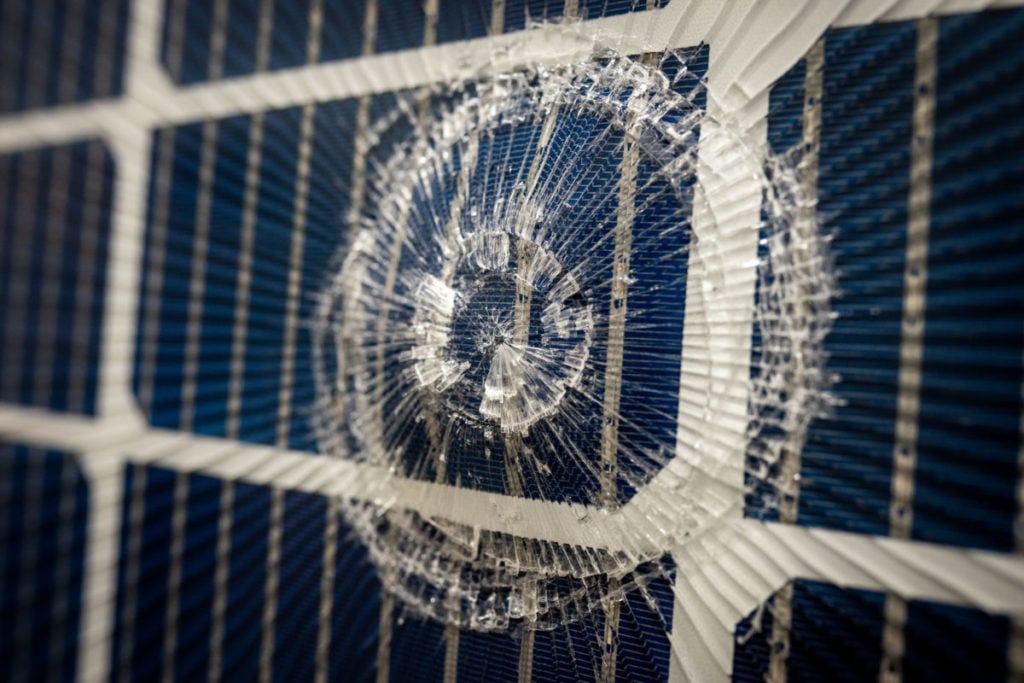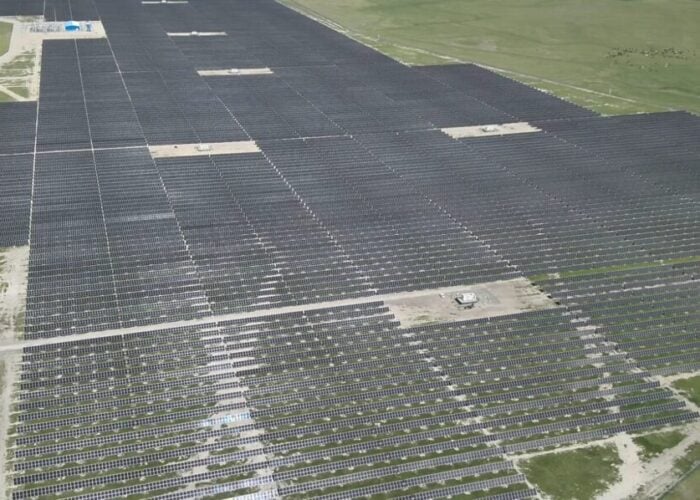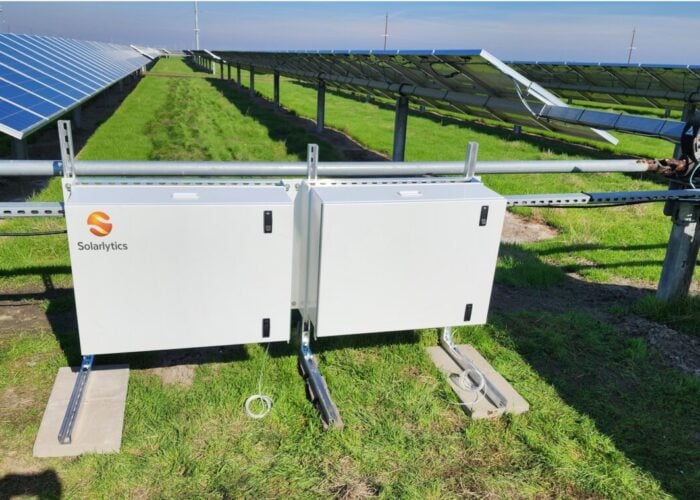
Hail represents a significant threat to PV modules, more so as climate change increases the potential for severe storms. Simon Yuen looks at some of the methods being used to protect solar projects against hail damage.
Unlock unlimited access for 12 whole months of distinctive global analysis
Photovoltaics International is now included.
- Regular insight and analysis of the industry’s biggest developments
- In-depth interviews with the industry’s leading figures
- Unlimited digital access to the PV Tech Power journal catalogue
- Unlimited digital access to the Photovoltaics International journal catalogue
- Access to more than 1,000 technical papers
- Discounts on Solar Media’s portfolio of events, in-person and virtual
Among the many extreme weather events impacting on PV plants, hail is one that has the potential to cause significant damage. A single hailstorm can be devastating, but climate change is likely to bring bigger hailstorms with more hail in the future.
According to PV Evolution Labs (PVEL), the most significant contributor to insured losses from thunderstorms worldwide is severe hail — defined as hail larger than 25mm in diameter. Globally, hail severity is expected to increase, as meteorologists are forecasting more frequent hailstorms worldwide. Not only that, but with more moisture in the air and more powerful updraughts, there is a strong chance that hailstones will become larger.
Hail basics
Hail occurs during thunderstorms which are usually triggered by an updraught – a storm’s early development, during which warm air rises to a level where condensation begins and precipitation develops. As the inside of a hailstorm cloud is constantly moving and changing, it is impossible to forecast the moment when hail becomes too heavy to stay in the cloud. Where hail will land is unpredictable, as is the size of hail. Although climatological models are available for the probability of certain hail sizes in a given region, hail strikes are still completely random.
Against this backdrop, solar power plants are not uniformly affected by hailstorms, meaning that the severity of impacts on different solar PV plants from the same hailstorm could be different.
Moreover, PVEL says the important driver for hail damage is impact energy or kinetic energy, which is the amount of force that the hail inflicts on an object and how that object can react. Variables affecting impact energy include hail size and shape, mass and density, speed and the angle of incidence.
Among these factors, mass and density are worth mentioning. Hail smaller in diameter can be denser and more destructive than larger slushy hail that may weigh less. The density of naturally occurring hail can range from about 0.32g per cm3 to 1g per cm3.
The angle of a hail strike affects the direction and distribution of the strike’s force across the surface area of a module. A module mounted horizontally will be subject to higher impact energy and incur more damage than the same module stowed at a tilt.
Industry tests
Although hail strikes could cause serious damage to solar PV plants, a meticulous plan could help mitigate losses.
PVEL’s Hail Stress Sequence replicates the impact energy of natural hail and simulates field conditions to assess PV module durability. The Hail Stress Sequence is also a required test in the latest version of PVEL’s PV Module Product Qualification Program (PQP).
In November, PVEL updated its PQP with four major changes, including refocusing the Hail Stress Sequence on identifying the threshold of glass breakage, among others.
During the Hail Stress Sequence, sample modules are struck by a 50mm lab-manufactured ice ball at terminal velocity (32 meters per second) in 11 different locations at a zero-degree angle. PVEL adds that the simulated hail strikes deliver an impact energy of 31.4 joules, comparable to the approximate impact energy of a 77mm strike with the same density at terminal velocity at 30 degrees.
Generally speaking, laboratory-made hail is extremely dense and more uniform than natural hail, so its impact energy is usually far greater; the impact energy of a lab-made 50mm ice ball is comparable to a natural hailstone as large as 100mm in diameter, depending on their density and impact angle.
PVEL has assessed more than 1GW of hail-damaged projects, identifying three consistent patterns of hail damage.
First, in strings with two or more broken glass modules, the cells of the remaining modules with intact glass are likely to experience severe cracking. Second, in sites with a capacity of more than 100MW that suffer glass breakage from hail, it is likely that some areas of the array will not have any cell damage. Third, glass breakage and cell cracking will be variable in the areas of the site between the two above extremes.
Speaking of the test results, Tristan Erion-Lorico, vice president of sales and marketing at PVEL, says the glass breakage rate of glass-glass modules could reach 89% if they are impacted by hail of 50mm diameter. “That should be quite alarming considering how prevalent glass-glass modules are these days,” he comments.
However, the glass breakage rate drops to only 34% for glass-backsheet modules that use fully tempered glass.
PVEL is not the only company offering testing services. US independent test lab Renewable Energy Test Center’s (RETC) Hail Durability Test Program assesses the characteristics of the PV modules and their bills of materials, attaining test results by using repeatable speeds and consistency in ice ball quality.
During the testing programme, PV modules undergo a simulation of conservative wind speeds and are checked for their performance near the threshold of damage, just over the threshold, which is repairable damage, and at material failure.
RETC CEO and president Cherif Kedir says understanding hail resilience requires kinetic energies an order of magnitude larger than those found in module certification standards, such as IEC/UL 61215
and IEC/UL 61730.
“RETC’s Hail Durability Test Program expands and improves upon minimum IEC/UL impact test requirements in three ways. First, it subjects modules to higher kinetic impact energies to better reflect the hail risk over a 25- or 30-year operating life,” says Kedir.
“Second, it thoroughly investigates a range of possible outcomes — from cell cracking to glass breakage — which provides valuable data for probabilistic analyses. Third, it includes thermal cycle and hot-spot tests to reveal potential long-term module degradation modes.”
Asked what types of modules fare better in general, Erion-Lorico says modules with fully tempered glass are less likely to break due to hail. However, Kedir offers a different answer.
“Our data indicate that PV module hail resilience or vulnerability is largely a function of glass thickness and strengthening, but what might surprise people is that this relationship between glass thickness and impact resistance is not necessarily linear,” he says.
“As true heat-tempered glass is generally twice as strong as glass that is ‘heat-strengthened’ only, our test data shows that PV modules made with 3.2mm fully tempered front glass are approximately twice as resilient to impact as modules packaged with 2.0 mm heat-strengthened front glass.”
Kedir says qualification tests represent the legal minimum requirements for product performance and safety. However, as these tests are not intended to predict long-term reliability or performance in real-world applications, beyond-qualification hail testing should be the norm for project stakeholders developing and deploying large solar farms in hail-prone regions.
Erion-Lorico agrees that beyond-qualification testing should be the form for modules deployed in hail-prone regions but adds that the solar manufacturing industry should start designing modules for certain climates. “There’s no need to have every module on the market be ‘hail-hardened’, but companies should offer such modules for sites where that is important,” he says.
Early warning systems
In addition to module resilience, solar developers can also rely on hail risk assessments to better protect solar PV plants.
Engineering advisory and test services provider VDE Americas offers solar project hail risk assessments based on site-specific meteorological data from a small grid area spanning about 16 square kilometres, as well as product-specific technical details. The reports produced by VDE Americas provide solar project stakeholders with financial loss and risk exposure estimates based on project-specific lat-long coordinates and fielded PV module and tracker technologies.
With the insights from the reports, solar developers can guide equipment specification, insurance terms and risk exposure beyond insurance coverage.
“Some examples of work we’re supporting include providing maps to developers to make better siting and equipment procurement decisions, helping module manufacturers design hardened modules, and working with tracker companies and operators to launch automated hail monitoring and stow procedures,” says Jon Previtali, senior principal engineer of VDE Americas.
As we discussed at the beginning of this article, hail strikes are completely random. Therefore, there may be no advance warning if hail forms directly over a site.
“So, project stakeholders may want to monitor weather conditions hours before a possible hailstorm and put the project into hail stow well before any hail alert. Since stormy days tend to be cloudy, it may be worth sacrificing a small amount of energy production to optimise hail risk mitigation,” Previtali says.
Stowing modules
The possibility of mitigating losses stemming from hail strikes can be further enhanced by using the appropriate stowing strategy.
According to Nicole Thompson, data scientist at climate insurance provider kWh Analytics, moving panels into hail stow, where trackers are placed in a high degree tilt to reduce the impact energy of hailstones, is an effective and well-documented mitigation technique. However, this practice could move the modules out of an optimal production angle, and solar developers may delay this move until hail falls, limiting this mitigation strategy’s effectiveness.
To test whether it’s worth stowing the modules before a hailstorm, kWh Analytics simulated one-year production for a 200MW single-axis tracker site. The site was modelled under two scenarios. First, it assumed no hail stow. Second, the simulation took a 60-degree stow during all US National Weather Service (NWS) severe thunderstorm watches, warnings and advisories (WWA).
Under a US$22 per MWh power purchase agreement (PPA), moving into the hail-stow mode during WWA events throughout the year for this particular simulated site resulted in a total production loss of US$12,000, or 0.1% of the US$9.75 million estimated annual revenue.
Thompson says: “If you consider this with the fragility of modules in the face of hail and the quick onset of hailstorms, the picture becomes clear: stow early, and stow often.”
Thompson also examines how to stow modules to minimise losses incurred by hail.
“The best strategy is to proactively stow panels at the first sign of potential severe weather. In an ideal world, modules would be stowed away from the direction of the wind, but the shifting gusts make it difficult, if not impossible, to predict.
“Implementing hail stow at the earliest indication of severe weather, in addition to the best guess of wind direction, provides the maximum protection,” she says.
Insurance
In 2019, a solar farm in Texas was damaged by a hailstorm, causing insurance losses totalling US$70 million. Given the rise in extreme weather events, coverage for damage from these events, including hail, should be included, as advised by Thompson.
As insurers may have varying levels of data and expertise in the solar industry, only a few of them are capable of accounting for solar-specific resilient factors in their underwriting.
“The most sophisticated, data-driven managing general agents are best positioned to model catastrophe risks and provide consideration for operational, regional, technical, and proactive resiliency measures,” Thompson says. “Asset owners would be wise to seek all available market quotes for property insurance, as some insurers may provide more beneficial terms for risk mitigation efforts than others.”







